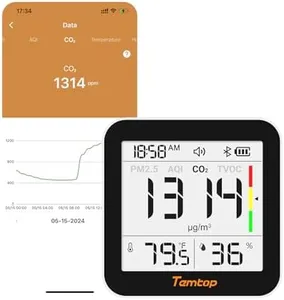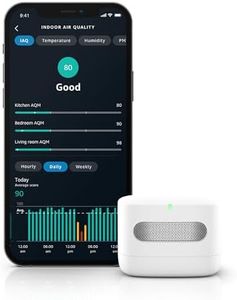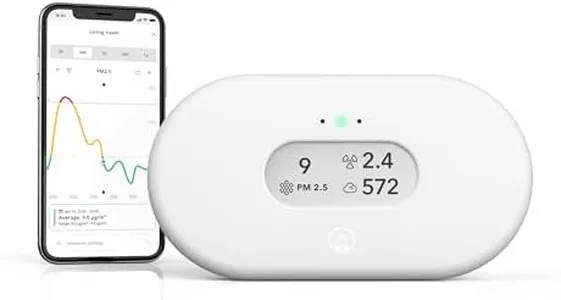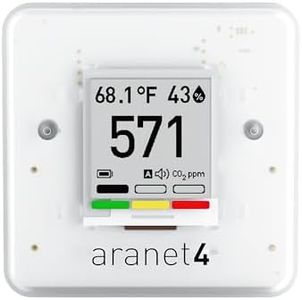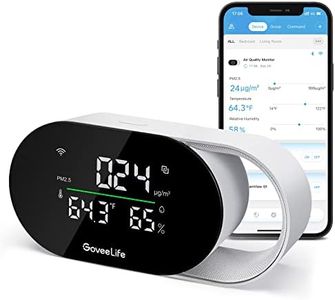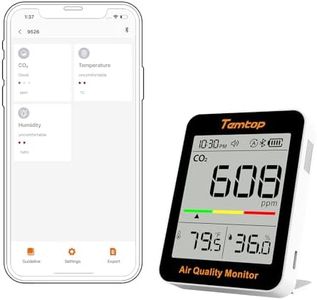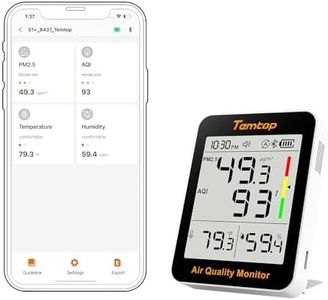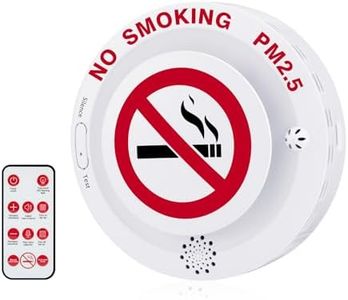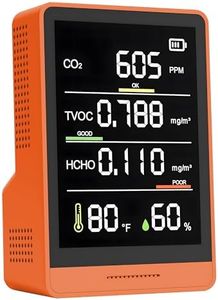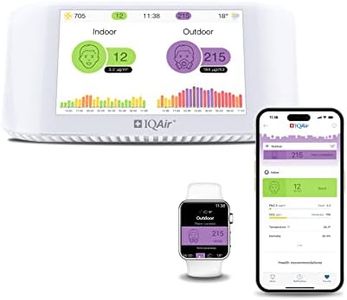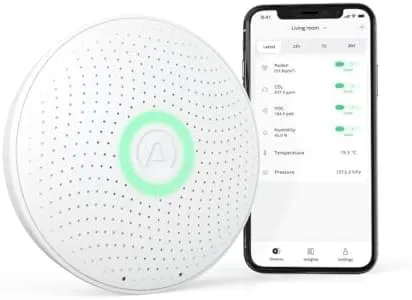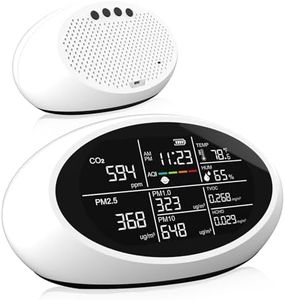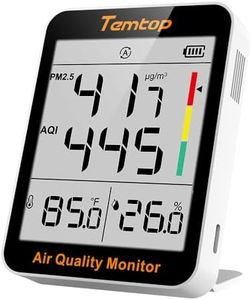10 Best Indoor Air Quality Monitors 2025 in the United States
Our technology thoroughly searches through the online shopping world, reviewing hundreds of sites. We then process and analyze this information, updating in real-time to bring you the latest top-rated products. This way, you always get the best and most current options available.

Our Top Picks
Winner
Amazon Smart Air Quality Monitor – Know your air, Works with Alexa
Most important from
4936 reviews
The Amazon Smart Air Quality Monitor is designed to help you keep track of your indoor air quality by measuring five key factors: particulate matter (PM 2.5), volatile organic compounds (VOCs), carbon monoxide (CO), humidity, and temperature. One of its strengths lies in its accurate sensors, which provide reliable data on air quality. The color-coded LED indicator gives a quick visual representation of air quality, and detailed scores can be viewed through the Alexa app.
This is particularly user-friendly for those already using Alexa-enabled devices, as it integrates seamlessly into the Amazon ecosystem. The device can also send notifications to your phone or announce on Echo devices if poor air quality is detected, which is a handy feature for proactive monitoring. Additionally, it supports routines to automate your air purifiers, dehumidifiers, and fans based on air quality changes, enhancing your home's comfort.
However, the accuracy for some measurements, like VOCs and PM 2.5, can vary, and it only covers typical indoor ranges (15°C to 30°C for temperature and 30% to 70% for humidity). The device is compact and portable, weighing just 120 grams, and is powered by a standard 5V micro-USB adapter, making it easy to place anywhere indoors. The setup is straightforward, especially for non-experts, thanks to its 'Certified for Humans' label. One downside is its reliance on a 2.4GHz Wi-Fi connection, which might be less desirable for those with dual-band routers. This monitor is best suited for users who want a simple, integrated way to keep an eye on their indoor air quality, especially if they are already part of the Alexa ecosystem.
Most important from
4936 reviews
Airthings 2960 View Plus - Battery Powered Radon & Air Quality Monitor (PM, CO2, VOC, Humidity, Temp, Pressure)
Most important from
1510 reviews
The Airthings 2960 View Plus is a solid choice for those looking to monitor indoor air quality, especially when it comes to detecting radon—a significant health risk. Its range of sensors allows it to measure various pollutants, including PM2.5, CO2, and VOCs, making it a comprehensive tool for understanding air health in your home. The WiFi connectivity lets you check your air quality in real-time via the Airthings app, which provides valuable notifications and historical data analysis.
One of the standout features is its accuracy, particularly for radon detection, which is crucial since radon is linked to lung cancer. The device is also battery-powered, granting you the flexibility to place it wherever needed without worrying about cords. Its eInk display is user-friendly and customizable, making it easy to monitor your air quality at a glance.
There are a few drawbacks to consider. The requirement for an app and internet access may be a hurdle for users who prefer simpler devices. Some users have noted that the accuracy for other measurements can vary, and while it has a good customer rating, a small percentage of users reported connectivity issues with the app. Additionally, the reliance on batteries means that you'll need to replace them approximately every two years, which could be an inconvenience for some.
The Airthings 2960 View Plus is particularly suitable for health-conscious individuals or families wanting to improve their indoor air quality, but it may not be the best fit for those looking for a straightforward, battery-free solution.
Most important from
1510 reviews
SAF Aranet4 Home: Wireless Indoor Air Quality Monitor for Office or School (CO2, Temperature, Humidity and More) Portable, Battery Powered, E-Ink Screen, App for Configuration & Data History
Most important from
1563 reviews
The SAF Aranet4 Home is a portable indoor air quality monitor that excels in providing real-time data on CO2 levels, temperature, and humidity. It uses advanced NDIR sensor technology, which enhances its measurement accuracy, making it a reliable choice for anyone wanting to improve their indoor air quality. The e-ink display is a standout feature, offering excellent visibility of important data while being energy-efficient. With a battery life of up to four years, you won't need to worry about constant recharging or replacing batteries often. This monitor is particularly user-friendly, with a color-coded display and an optional buzzer alert that notifies you when CO2 levels become concerning. The accompanying smartphone app adds significant value, allowing users to access and analyze historical data over the last 90 days with ease, aided by helpful graphs. This makes it ideal for individuals and organizations aiming to maintain healthy indoor environments, such as schools and offices.
There are some considerations to keep in mind. While the device is compact and portable, it lacks advanced connectivity options, such as Wi-Fi or Bluetooth, which could limit integration with other smart home systems. Also, the monitor only measures a select few variables (CO2, temperature, humidity, and atmospheric pressure), which might not meet the needs of users looking for a more comprehensive air quality analysis that includes pollutants like VOCs or particulate matter. Additionally, the reliance on battery power might not be ideal for all users, especially those who prefer plug-in devices.
The Aranet4 is a solid choice for anyone looking to monitor indoor air quality effectively, featuring accurate readings and user-friendly characteristics. It best serves users in settings like offices and educational institutions, where maintaining a healthy atmosphere is essential, but it may fall short for those desiring a more extensive array of features.
Most important from
1563 reviews
Buying Guide for the Best Indoor Air Quality Monitors
Choosing the right indoor air quality monitor is essential for ensuring a healthy living environment. These devices help you keep track of various pollutants and conditions in your home, allowing you to take action to improve air quality. When selecting an indoor air quality monitor, it's important to understand the key specifications and how they relate to your specific needs. Here are the main factors to consider when making your choice.FAQ
Most Popular Categories Right Now
